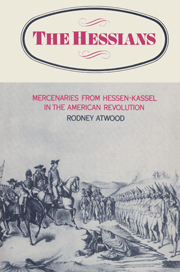Book contents
- Frontmatter
- Contents
- List of maps
- Acknowledgements
- Abbreviations
- Note on German ranks and currency
- Introduction
- 1 The German soldier trade
- 2 The Hessians go to America
- 3 The victories of 1776
- 4 The Battle of Trenton
- 5 The campaigns of 1777–81
- 6 Anglo-Hessian relations
- 7 The Hessian view of the American Revolution
- 8 Hessian plundering
- 9 Hessian desertion
- 10 Recruiting in Germany
- 11 The impact of the war on Hessen
- 12 Conclusion
- Appendices
- Bibliography
- Index
2 - The Hessians go to America
Published online by Cambridge University Press: 04 August 2010
- Frontmatter
- Contents
- List of maps
- Acknowledgements
- Abbreviations
- Note on German ranks and currency
- Introduction
- 1 The German soldier trade
- 2 The Hessians go to America
- 3 The victories of 1776
- 4 The Battle of Trenton
- 5 The campaigns of 1777–81
- 6 Anglo-Hessian relations
- 7 The Hessian view of the American Revolution
- 8 Hessian plundering
- 9 Hessian desertion
- 10 Recruiting in Germany
- 11 The impact of the war on Hessen
- 12 Conclusion
- Appendices
- Bibliography
- Index
Summary
THE TREATY OF 1776
By 1776 the hiring of military corps in return for subsidies, by one state from another, was accepted in international law as well as practice. In 1758 the jurist Emer de Vattel defined auxiliaries thus:
When a sovereign, without taking a direct part in a war carried on by another sovereign, merely sends him help in the form of troops or vessels of war, these troops or vessels are called auxiliaries.
Auxiliary troops serve the prince to whom they are sent, in accordance with the orders of their sovereign. If they are sent to him without any conditions or restrictions they will be at his service equally for offensive or defensive war, and will be under obedience to him with respect to the duties they are to perform.
A subsidy was either money paid by one sovereign to another to aid the latter in war or ‘a sum of money which one sovereign annually pays to another in recompense for a body of troops which the latter furnishes him in his wars, or holds ready at his service’. Agreements for such troops were ‘treaties of subsidy’. To establish the morality and legality of such treaties, Vattel laid down the principle that aid could be given to a nation waging a just war, but not to one in an unjust war.
- Type
- Chapter
- Information
- The Hessians , pp. 22 - 57Publisher: Cambridge University PressPrint publication year: 1980



